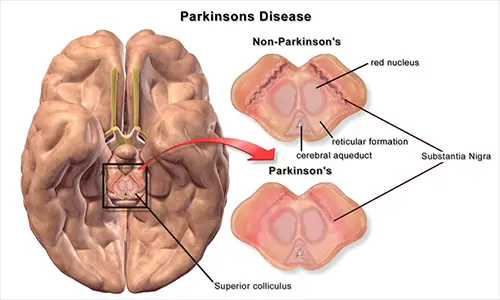1. Parkinson’s disease affects older people.
• The risk of developing the disease increases with age.
• Onset of the disease is usually between ages of fifty and sixty five.
2. Parkinson’s disease is more common in men.
• An incidence based studies have been conducted determining the mortality rate and prevalence resulted to be men on the greater risk than women.
• Among the factors identified were toxicant exposure, X linkage of genetic material and head trauma.
3. Parkinson’s disease is a neurodegerative disease.
• Parkinson’s disease is named after the doctor who first identified this condition, Dr. James Parkinson.
• It is the second most common neurodegenerative disease next to Alzheimer’s disease. .
• It is a chronic disease characterized by degeneration of nerve cells in the part of the brain that produce he neuro chemical dopamine.
• Dopamine is a neurotransmitter responsible in the communication of neurons to regulate motor functions.
• Imbalances of these neurotransmitters cause the person to loss his ability to control body movements.
4. Parkinson’s disease early signs are subtle.
• Deterioration of balance and coordination may take up to six to ten years following initial manifestation of symptoms of the disease.
• Presenting symptoms are:
o Weakness in one limb and muscle rigidity.
o Resting tremors on one hand.
o Slowing of movement (bradykinesia).
5. Parkinson’s disease has no known cure.
• Treatments are available to control the symptoms.
• Anti Parkinson’s drug is combined with other therapies is the treatment modalities widely used for the disease management
• Levodopa is the drug of choice for addressing motor symptoms of the disease. This medication is converted into dopamine by the brain enabling the patient to function well for some time. However, the effect of this medication does not provide the amount of dopamine for the body’s demand for the entire day.
6. Depression is one of the symptoms of Parkinson’s disease.
• This is the major defining factor of the overall quality of the patient’s life.
• There are about sixty percent of people with Parkinson’s experiences mild to moderate signs of depression.
• Psychological counseling may be beneficial in the management of this kind of emotional toll on patients as well as their significant others.
7. Exercise can potentially slow the progression of some of the symptoms of Parkinson’s disease.
• Aside from enhancing heart and lung function, individualized physical exercise may help improve gait, balance and grip strength in patients having the disease.
8. Parkinson’s can also be surgically managed.
• Some people may not be responsive with medications to control the fluctuation of dopamine that may lead to more debilitating symptoms.
• Deep brain stimulation is a procedure done surgically to deliver electrical signals to motor areas of the brain (for stimulation of neurons) and blocks abnormal electrical impulses that would eventually alleviated Parkinson’s disease motor symptoms.
9. Parkinson’s disease alters a person’s cognitive functioning.
• A decline in the patient’s cognition is a secondary symptom of the disease and nearly mimics dementia.
• Signs of cognitive impairment include loss of intellectual capacity and forgetfulness.
10. Care of a person with Parkinson’s disease requires emotional support.
• As the disease progresses, caring of the person becomes more challenging.
• Family of the person should also take an active role in the care of the person.
• An understanding of the disease itself is the key tool in provision of hands-on care and emotional support they need.
• By maintaining a good relationship with your loved one, your also enhancing their sense of well-being at the same time giving them the chance to live a normal life.











Leave a Reply